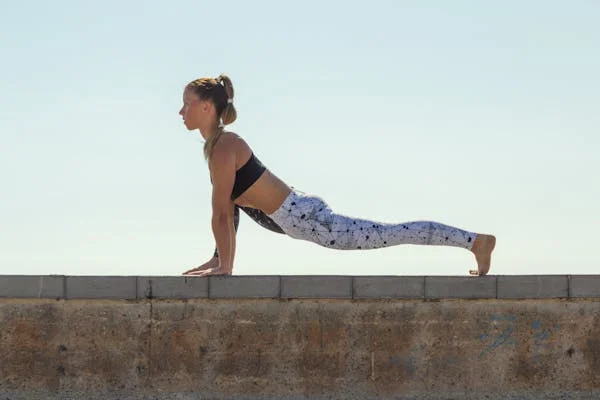Table of Contents
Introduction
Ashtanga Yoga is often seen as a rigorous and transformative practice that combines strength, flexibility, and mental clarity in a dynamic flow.
Yet, behind the intensity of the postures and the discipline of the practice lies a deeper essence—a connection to self, a pathway to inner peace, and a profound tool for personal growth.
Whether you are someone just starting your yoga journey or you’re already familiar with yoga, Ashtanga Yoga offers an opportunity to unlock your fullest potential.
In this blog, we will take a deep dive into Ashtanga Yoga, explore its core philosophy, its transformative benefits, and how this ancient practice can help you unleash your true power.

What Is Ashtanga Yoga?
Ashtanga Yoga is a system of yoga that goes beyond just the physical practice. The word “Ashtanga” is derived from two Sanskrit words: ashta, meaning “eight,” and anga, meaning “limb.”
These eight limbs, or practices, form the essence of the yoga system, which is designed to guide individuals toward greater spiritual awakening and enlightenment.
The practice includes a combination of physical postures (asanas), breath control (pranayama), and mental focus that creates a harmonious connection between the mind, body, and spirit.
The origins of Ashtanga Yoga can be traced back to the ancient texts of yoga, particularly the Yoga Sutras of Patanjali. Sri K. Pattabhi Jois, a renowned yoga master, later systematized and popularized Ashtanga Yoga in the 20th century.
His teachings laid the foundation for modern Ashtanga Yoga, which is practiced worldwide today.
While the physical postures are often the most noticeable aspect of the practice, Ashtanga Yoga also emphasizes ethical principles, meditation, and self-discipline.
The practice is holistic, addressing not only the body but also the mind and spirit, offering a path toward personal transformation and inner peace.


The Eight Limbs of Ashtanga Yoga
Ashtanga Yoga is called the “eight-limbed path” because it includes eight interconnected practices, each one playing a crucial role in leading the practitioner toward self-realization and spiritual growth.
These eight limbs form a comprehensive guide for a balanced life. Let’s break down these eight principles:
- Yama (Moral Restraints)
The first limb of Ashtanga Yoga, Yama, consists of ethical guidelines that govern our actions in relation to others. There are five main Yamas: - Niyama (Personal Observances)
Niyama refers to the observances and disciplines we practice to cultivate self-purification and personal growth. These five observances help us develop inner contentment, focus, and mindfulness:- Saucha (cleanliness) is not just about physical cleanliness, but also mental and emotional purity.
- Santosha (contentment) is about finding peace with where we are, rather than always striving for more.
- Tapas (discipline or effort) is the fire that drives us to consistently practice and challenge ourselves.
- Svadhyaya (self-study) encourages us to reflect on our thoughts and actions to gain a deeper understanding of ourselves.
- Ishvara Pranidhana (devotion to a higher power) is about surrendering to the divine and practicing humility.
- Asana (Physical Postures)
Asana refers to the physical practice of yoga postures. The asanas in Ashtanga Yoga are performed in a specific sequence, and each posture is linked with a breath. These movements help cultivate strength, flexibility, and stability, not just physically, but mentally as well. The steady practice of asanas also prepares the body for meditation, allowing us to sit comfortably in stillness. - Pranayama (Breath Control)
Pranayama is the practice of controlling the breath, or life force energy (prana), within the body. The breath is intimately linked to the mind, and by learning to regulate our breathing, we can calm the mind and enter a state of deep focus. In Ashtanga Yoga, pranayama is practiced in conjunction with the physical postures to create a harmonious flow of movement and energy. - Pratyahara (Withdrawal of the Senses)
Pratyahara is the practice of withdrawing the senses from external distractions. It involves turning inward and focusing the mind away from external stimuli. This practice helps create mental space, allowing us to gain clarity and calmness, which are essential for deep meditation. - Dharana (Concentration)
Dharana refers to the practice of concentration, where the mind is focused on a single point of attention, whether it’s a visual object, mantra, or the breath. It helps train the mind to be present and undistracted, allowing us to focus on the task at hand without being pulled away by external thoughts or distractions. - Dhyana (Meditation)
Dhyana is a deeper state of meditation that follows from concentration. While concentration is the ability to hold the mind on a single object, meditation is the state of flow where the mind becomes absorbed in the experience. Dhyana allows us to experience a deep connection with the present moment and a profound sense of inner peace. - Samadhi (Enlightenment)
The final limb, Samadhi, represents the ultimate state of union with the divine. In this state, the practitioner transcends the individual ego and experiences oneness with the universe. Samadhi is often described as a state of bliss and profound inner peace, where the boundaries between the self and the world dissolve.


The Physical and Mental Benefits of Ashtanga Yoga
Ashtanga Yoga is not just about performing postures—it is about engaging the body, breath, and mind in a deeply transformative practice. The benefits of Ashtanga Yoga go far beyond physical fitness; it helps cultivate a peaceful and focused mind, improves emotional well-being, and promotes spiritual growth.
1. Physical Strength and Flexibility
Ashtanga Yoga is a powerful practice that builds strength and flexibility in the body. Through the repetitive flow of postures, practitioners develop muscular endurance and flexibility, which improves balance, posture, and coordination.
The Primary Series, for example, focuses on building foundational strength and alignment, while the Secondary Series deepens flexibility, particularly in the hips, shoulders, and spine.
2. Mental Clarity and Focus
Ashtanga Yoga is often referred to as “moving meditation” because the synchronization of breath and movement cultivates focus and concentration.
This practice helps to quiet the chatter of the mind and develop greater mental clarity. By concentrating on each breath and each movement, practitioners can cultivate a state of mindfulness, which carries over into everyday life, reducing stress and anxiety.
3. Detoxification and Health
The intense physical exertion of Ashtanga Yoga helps stimulate the circulatory and lymphatic systems, promoting detoxification.
As the body sweats during practice, toxins are released, leaving practitioners feeling revitalized and energized. The combination of physical postures, breath control, and meditation also boosts the immune system, improving overall health and vitality.
4. Spiritual Growth
While the physical postures are important, the spiritual aspects of Ashtanga Yoga are equally transformative. The practice encourages self-awareness and introspection, helping individuals connect with their true selves.
The principles of the Yamas and Niyamas offer a moral compass, guiding practitioners toward living a life of compassion, integrity, and self-discipline. Over time, Ashtanga Yoga can help you uncover a deeper sense of purpose and spiritual fulfillment.
Starting Your Ashtanga Yoga Journey
If you’re new to Ashtanga Yoga, it’s important to start slowly and with patience. The practice can be challenging, especially in the beginning, but with consistent effort, you will begin to notice progress—both in your body and mind. Here are a few tips to help you get started:
- Start with the Primary Series
The Primary Series is the foundation of Ashtanga Yoga and is designed to detoxify and align the body. Don’t worry about getting every posture perfect; focus on getting familiar with the sequence and connecting breath with movement. - Practice Regularly
Consistency is key in Ashtanga Yoga. Even if you can only dedicate a short amount of time each day, make your practice a regular part of your routine. Over time, you will see improvements in both your physical strength and mental clarity. - Find a Teacher
While online tutorials can be helpful, working with an experienced Ashtanga Yoga teacher is invaluable. A teacher can help you refine your technique, prevent injuries, and provide valuable guidance along your yoga journey. - Respect Your Limits
Ashtanga Yoga can be intense, especially for beginners. It’s important to listen to your body and avoid pushing yourself too hard. Practice with patience, and remember that yoga is a lifelong journey of growth.


Ashtanga Yoga is a powerful and dynamic form of yoga that emphasizes the connection between breath and movement. Originating from the teachings of the ancient yogic text, the Yoga Sutras of Patanjali, it was later popularized in the 20th century by Sri K. Pattabhi Jois.
Ashtanga Yoga is often referred to as a “moving meditation” because it combines physical postures (asanas) with breath control (pranayama) in a fluid sequence.
The practice follows a set series of postures, each linked with a specific breath, creating a rhythmic and meditative flow that promotes mental focus and awareness.
What makes Ashtanga Yoga unique is its strict adherence to the same sequence of postures, ensuring consistency and depth of practice, which allows for gradual and progressive improvement.
The core principle of Ashtanga Yoga is vinyasa—linking breath with movement—and this method is what makes the practice both physically challenging and spiritually enriching.
The most commonly practiced series is the Primary Series (Yoga Chikitsa), which is designed to detoxify and align the body, followed by the Intermediate Series (Nadi Shodhana) and Advanced Series (Sthira Bhaga).
Practitioners progress through these series at their own pace, gradually increasing in difficulty as they develop strength, flexibility, and mental clarity.
Ashtanga Yoga is a holistic practice that benefits not just the body but also the mind and spirit. The physical postures build muscle strength, enhance flexibility, and improve balance, while the focus on breath and concentration helps reduce stress, anxiety, and mental clutter.
As practitioners become more attuned to their breath and body, they begin to cultivate a heightened sense of mindfulness, which carries over into daily life, helping them remain calm, focused, and present.
The practice also promotes detoxification through deep stretching and sweating, stimulating the body’s lymphatic and circulatory systems.
The eight-limbed path of Ashtanga Yoga goes beyond just physical postures, incorporating ethical guidelines (Yamas and Niyamas), concentration (Dharana), meditation (Dhyana), and ultimately, self-realization (Samadhi).
These eight limbs offer a comprehensive approach to living a meaningful and balanced life, both on and off the mat. Ashtanga Yoga is not just about achieving perfect postures; it is a journey of self-discipline, patience, and inner discovery.
Whether you’re a beginner or an experienced practitioner, the beauty of Ashtanga Yoga lies in its ability to help you tap into your true potential, fostering growth in every aspect of your life.
By committing to the practice with dedication and consistency, you can experience profound physical, mental, and spiritual transformation, unlocking the power within yourself.
Conclusion
Ashtanga Yoga is more than just a physical practice—it’s a complete system of self-transformation that encompasses the body, mind, and spirit.
By embracing the eight limbs of Ashtanga Yoga, you can unlock your true potential and experience profound personal growth.
Whether you are seeking better physical health, mental clarity, or spiritual awakening, Ashtanga Yoga provides a powerful pathway to a more balanced, fulfilled life.
So, step onto the mat, breathe deeply, and begin your journey of self-discovery. Through dedication and practice, you will discover that your true power lies within you.
